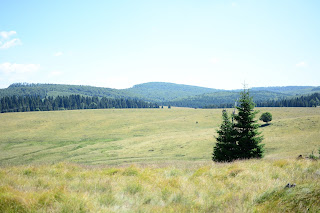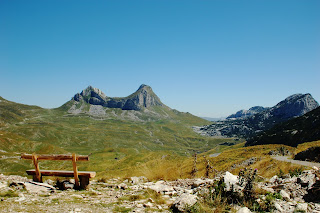DAY 11, PART: 1/2: Albania
Romania-Bulgaria-Greece-Macedonia-Albania-Montenegro with Aventura Maramures
Il. 1 Sunrise!
Finally we get on the right road (partially covered with asphalt!) to Berat - the city of a thousand windows (il. 2). Why a thousand? There used to be much less, and now, as in any burgeoning city the number of windows is still growing. Situated on a steep slope below the citadel, the houses of the old town (placed on UNESCO list), one over the other, give the impression as looking at traveler (especially wen you stand on the opposite bank of the river) by its bustling eyes / windows. By day, reflections of the sun are dancing on glazing, at dusk begun the game of lights inside houses lights.
Przebijamy się w końcu na właściwą drogę (miejscami asfaltową!) prowadzącą do Beratu - miasta tysiąca okien (il. 2). Dlaczego tysiąca? Niegdyś było ich znacznie mniej, a obecnie, jak w każdym rozrastającym się mieście wciąż ich przybywa. Usytuowane na stromym zboczu poniżej cytadeli, domy starego miasta (wpisane na listę UNESCO), wyglądające jeden ponad drugim, sprawiają wrażenie jakby patrzyły na podróżnego (szczególnie, gdy stoi się na przeciwległym brzegu rzeki) swymi ruchliwymi oczami/oknami. Za dnia po wprawionych w nie szybach tańczą refleksy odbiającego sie słońca, po zmierzchu rozpoczyna się gra zapalanych we wnętrzach domów świateł.
Il. 2 The thousand windows - eyes of Berat haouses
The first mention of this fascinating city already appear in the sixth century BC. Initially, it was a small settlement, later transformed into a fortress (Citadel built there by the Illyrian tribe in the fourth century BC, in the second century BC it was took over, strengthened and expanded by the Romans), and finally into a city with a turbulent history. The original building has survived even though the authorities of the lands has changing many times. For a time, it was ruled by Bulgarians, who called it Beligrad (White City), later it was take over by the ruler of Epirus, then the kingdom of Serbia, after that it was the capital of the Albanian principalities Muzaka family, passed through the hands of the Turks (Arnavud Belgrade - Albanian Belgrade) to come back again in the possession of the Albanians.
Pierwsze wzmianki o tym fascynującym mieście pojawiają się już w VI w p.n.e. Początkowo jest to niewielka osada, przekształcona później w twierdzę (Cytadelę zbudowało tam Iliryjskie plemię Dasaretów w IV w p.n.e, a w II w p.n.e. przejęli, umocnili i rozbudowali ją Rzymianie), a następnie w miasto o burzliwych losach. Oryginalna zabudowa przetrwała mimo, że zmieniali się władcy ziem, na których zostało wzniesione. Przez jakiś czas władali nim Bułgarzy zwąc je Beligradem (Białym Miastem), później przejął je władca Epiru, następnie królestwo Serbii, zostało stolicą albańskiego księstwa rodu Muzaka, przeszło przez ręce Turków (Arnavud Belgrad – Belgrad Albański), by znów wrócić w posiadanie Albańczyków.
Il. 3-4 The citadel
Meanwhile, we climbed the citadel, an area which is till today inhabited. From a top we see a great view of the city and... two giants! And here is a story:
A long time ago, in what is now Albania, there lived two brothers giants: Tomorri and Shpirag. They lived together in unison, until it turned out that they both fell in love with the same girl. The dispute over her, they decided to settle by duel. Unfortunately is ended tragicaly for all three. The fight was long, bloody and balanced. After every blow, giants legs sank deeper and deeper into the earth. In the end, every of them received so many wound, that the spirit of the two bodies had fled. Desperate girl unable to control her sadness, sat between them crying until her tears formed a river (Osum), separating the two brothers bodies. However, it hasn't soothe her grief, and she died of exhaustion. Girls corpse has turned to stone creating a hill-foundation for the citadel, while the Tomorii (il. 5) and Shpirag (il. 6) bodies turned into great mountains surrounding Berat city.
My tymczasem wspięliśmy się na cytadelę, na obszarze której po dziś dzień mieści się zamieszkała część miasta. Rozpościera się stąd wspaniała panorama na miasto i... dwa olbrzymy! A było to tak:
Dawno, dawno temu, na obszarze dzisiejszej Albanii, żyło dwóch braci olbrzymów: Tomorri i Shpirag. Żyli ze sobą w zgodzie, do czasu, gdy okazało się, iż obaj pokochali tę samą dziewczynę. Spór o nią postanowili rozstrzygnąć poprzez pojedynek, które dla całej trójki zakończył się nieszczęśliwie. Walka była długa, krwawa i wyrównana. Po otrzymanym ciosie, nogi olbrzymów grzęzły coraz głębiej w ziemi. W końcu każdy z nich otrzymał tyle ran, że duch z obydwu ciał uleciał. Zrozpaczona dziewczyna nie mogąc pohamować swego żalu, usiadła między nimi płacząc tak długo, aż z jej łez utworzyła się rzeka (Osum), rozdzielająca ciała braci. Nie ukoiło to jednak jej smutku i w końcu z wycieńczenia zmarła. Drobne zwłoki dziewczyny skamieniały i stały się wzgórzem-fundamentem pod cytadelę, która dała początek późniejszemu miastu, zaś ciała Tomorii (il. 5) i Shpiraga (il. 6) przemieniły się w wielkie góry okalające dzisiejszy Berat.
Il. 5 Tommori Mountain
Il. 6 Shpirag Mountain
Il. 7 City view
Il. 8 Bridge over the river Osum















































